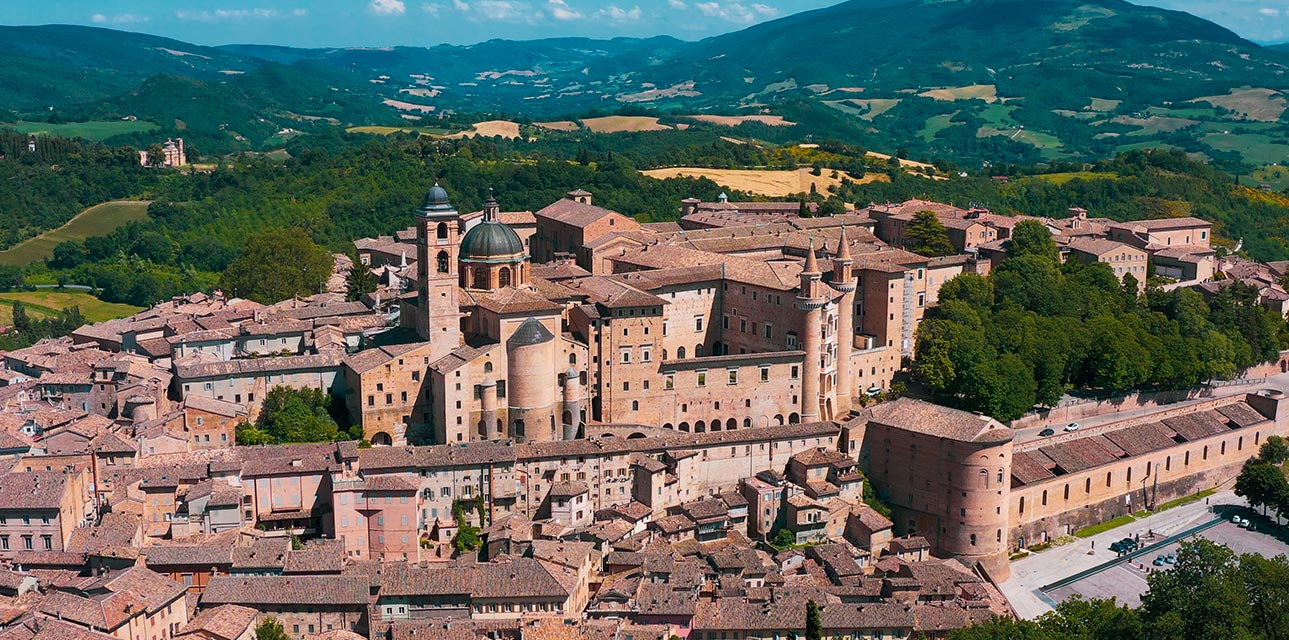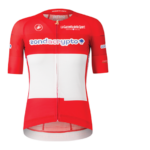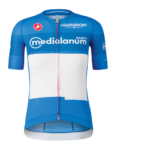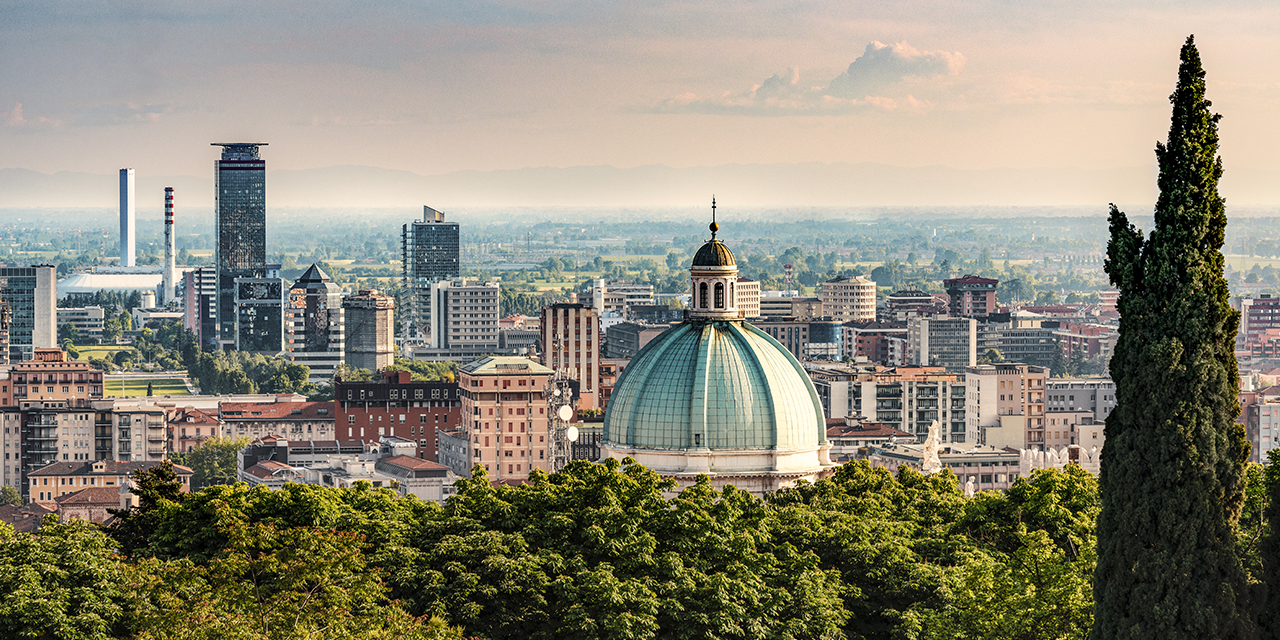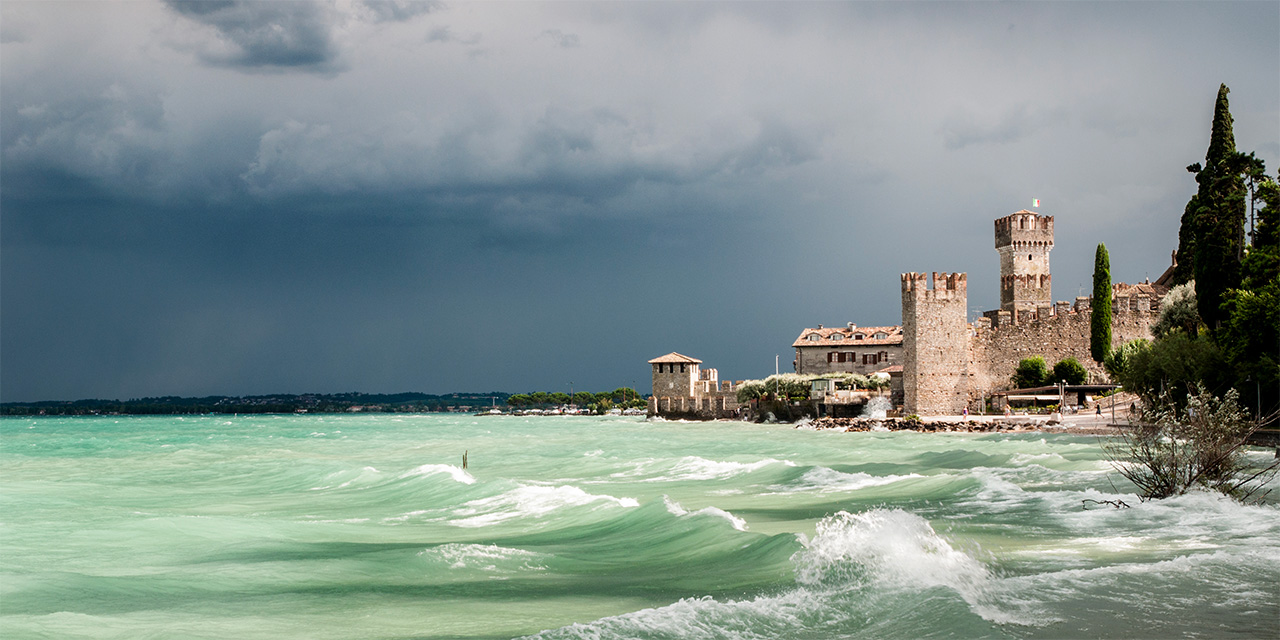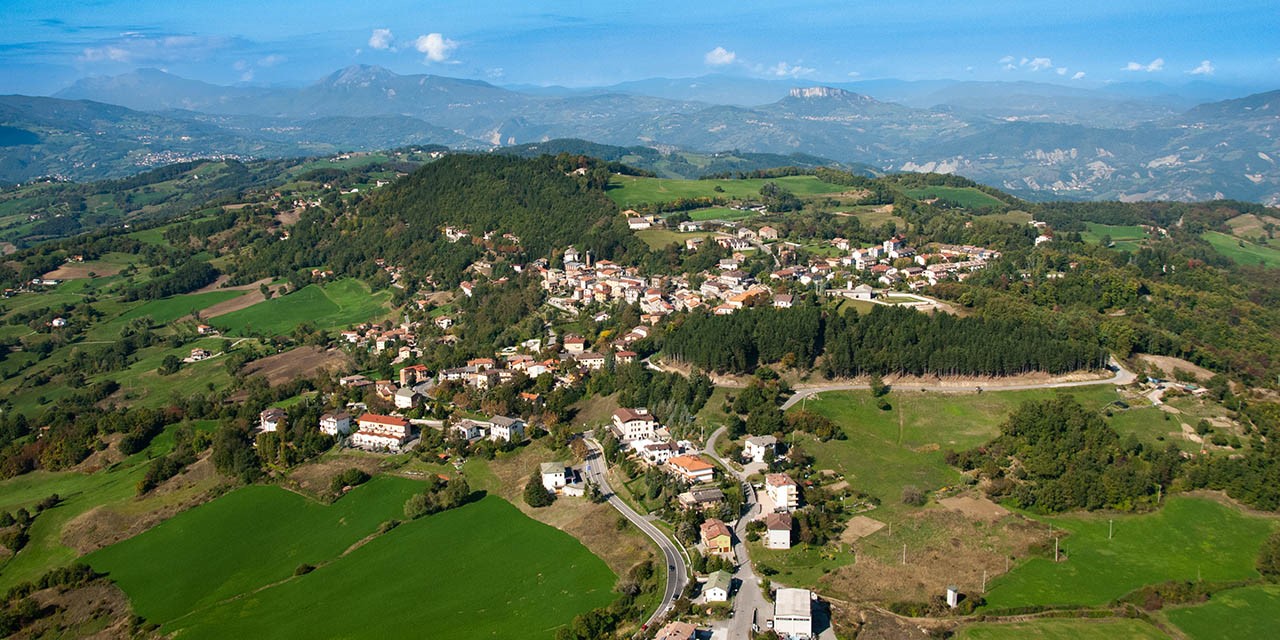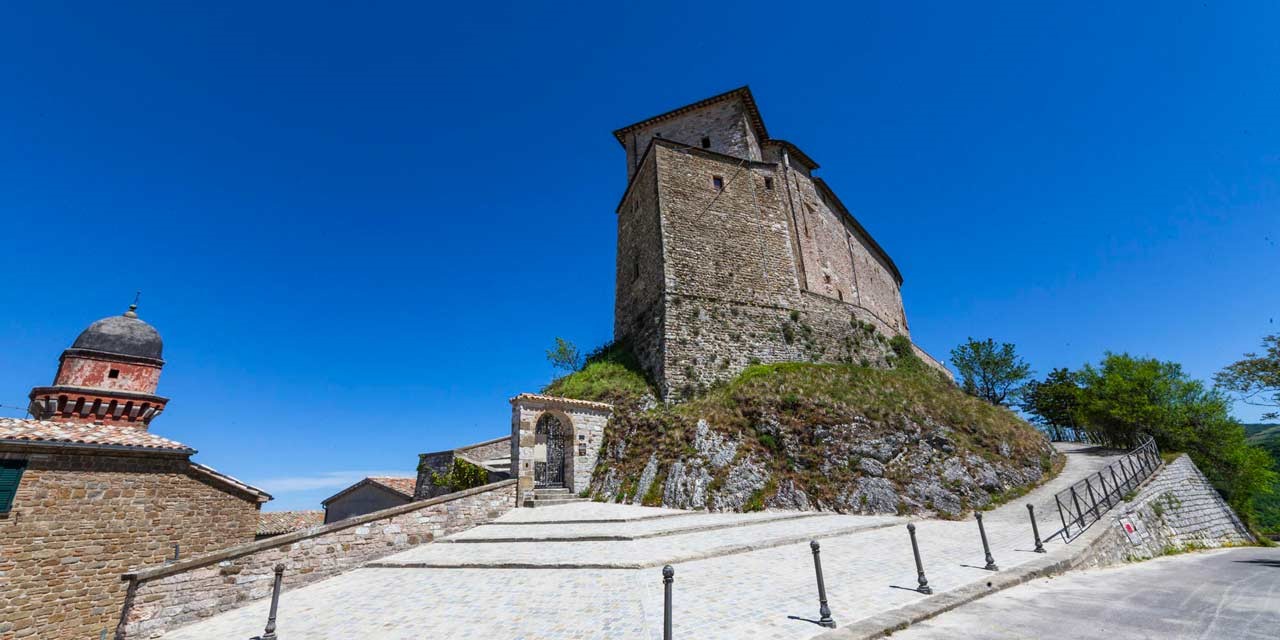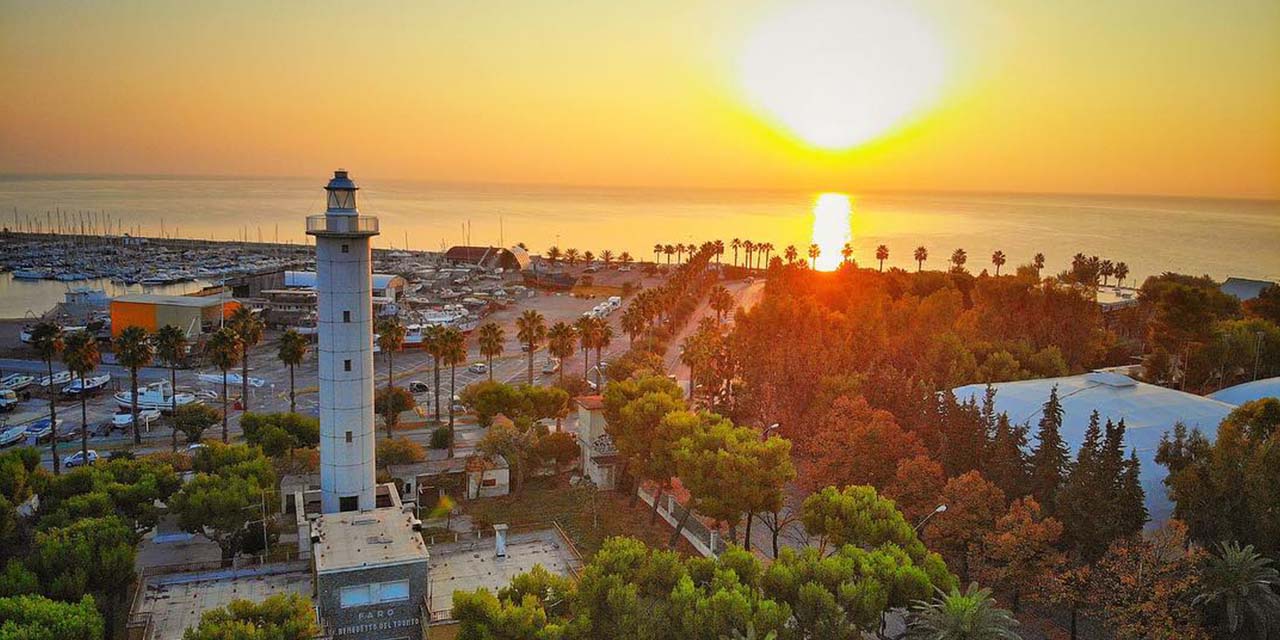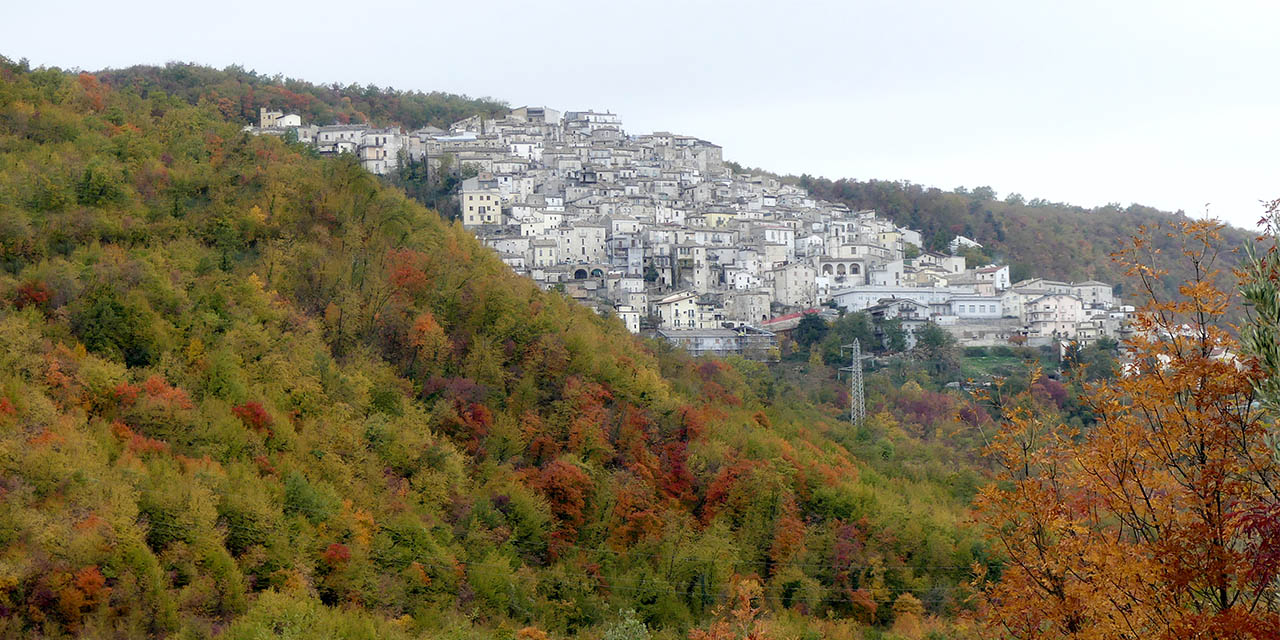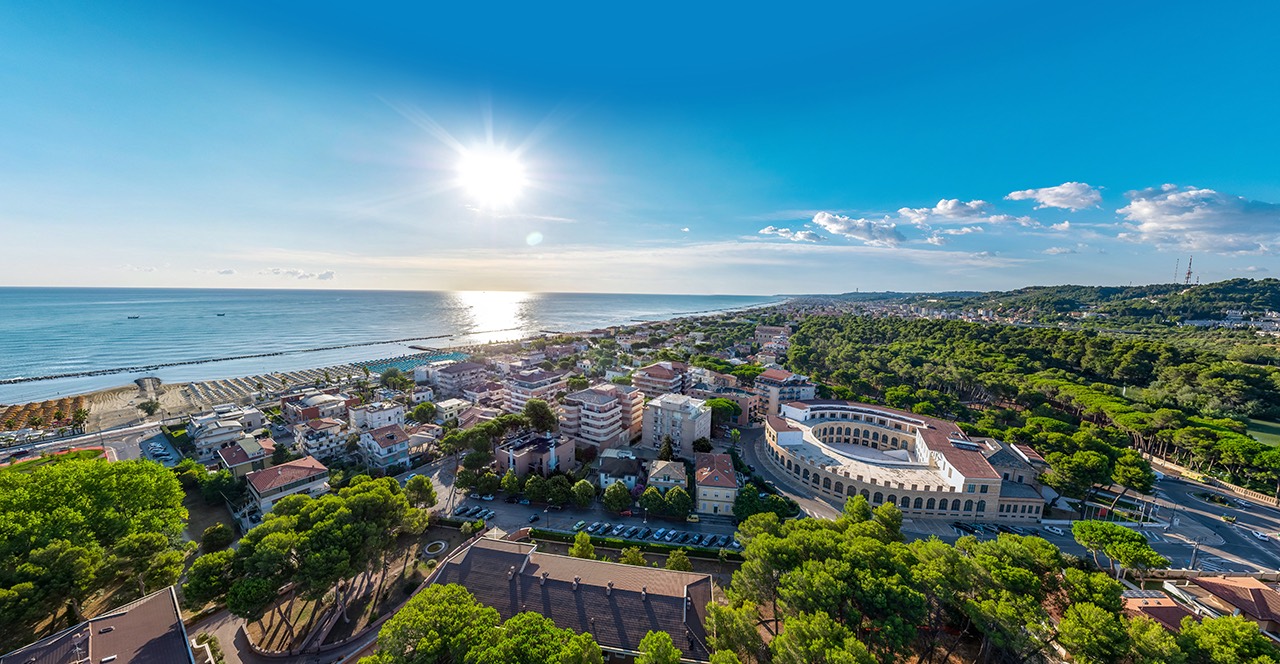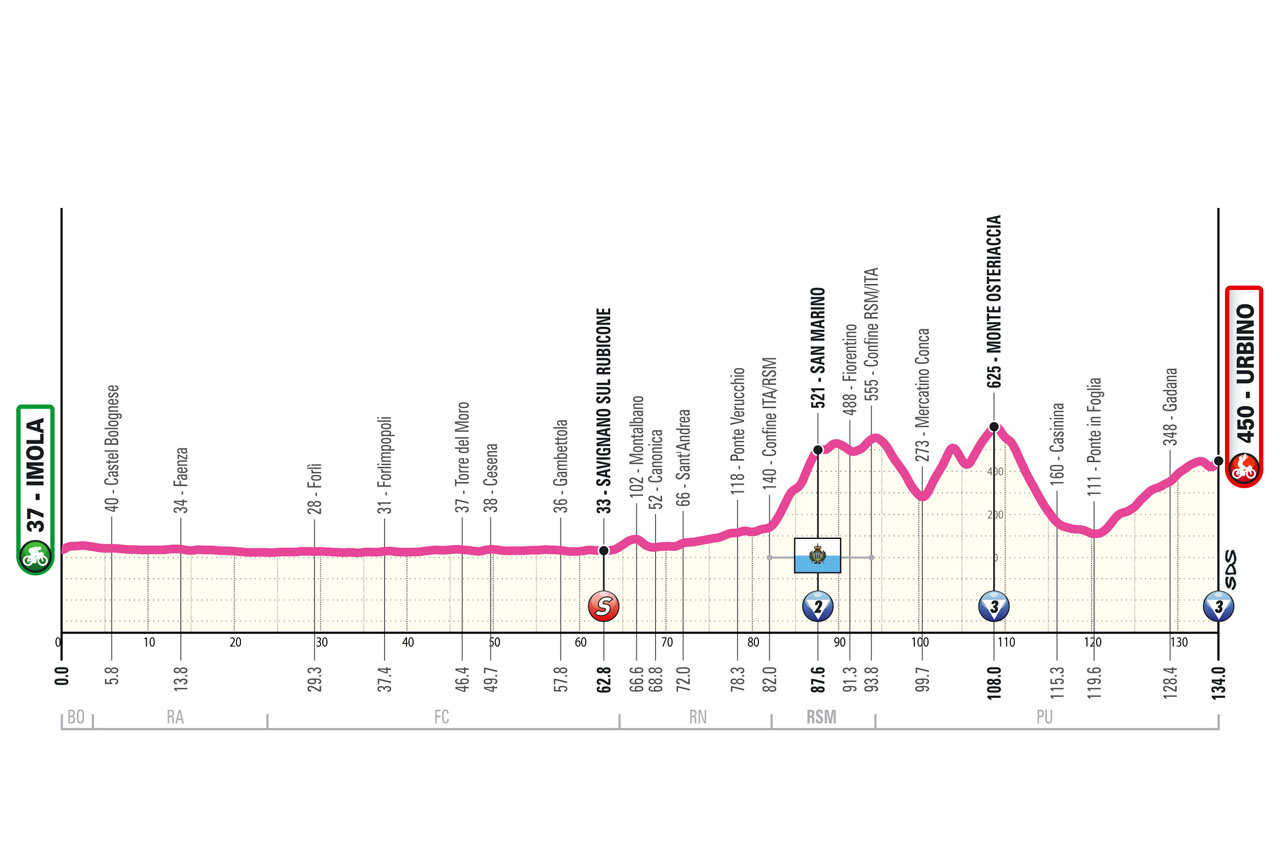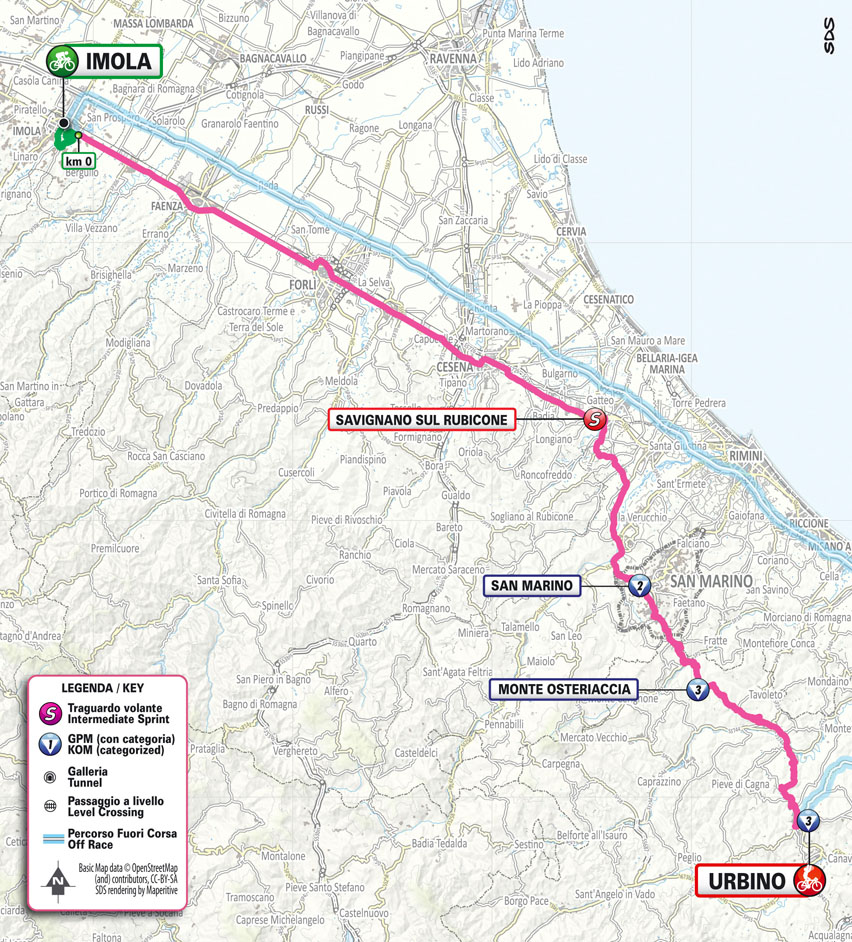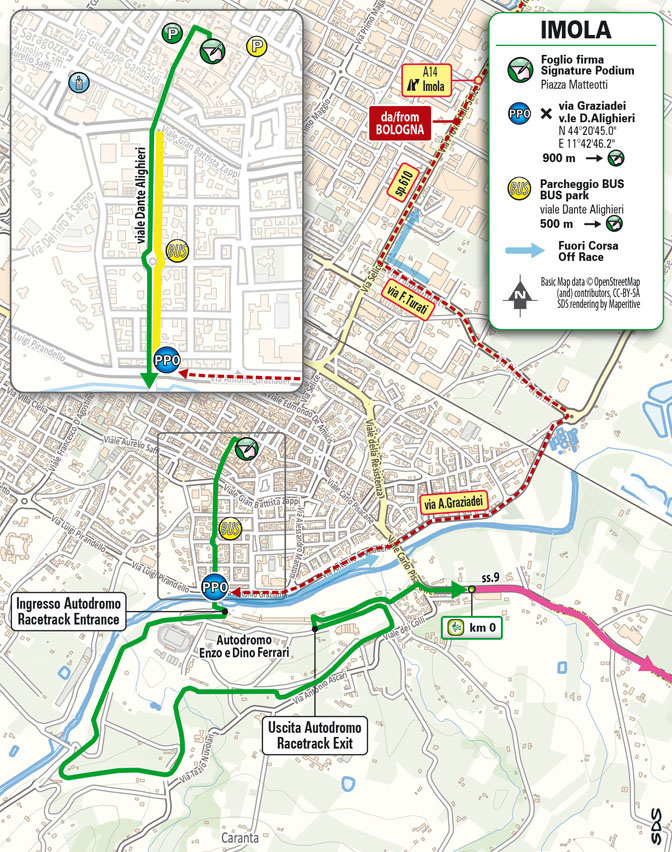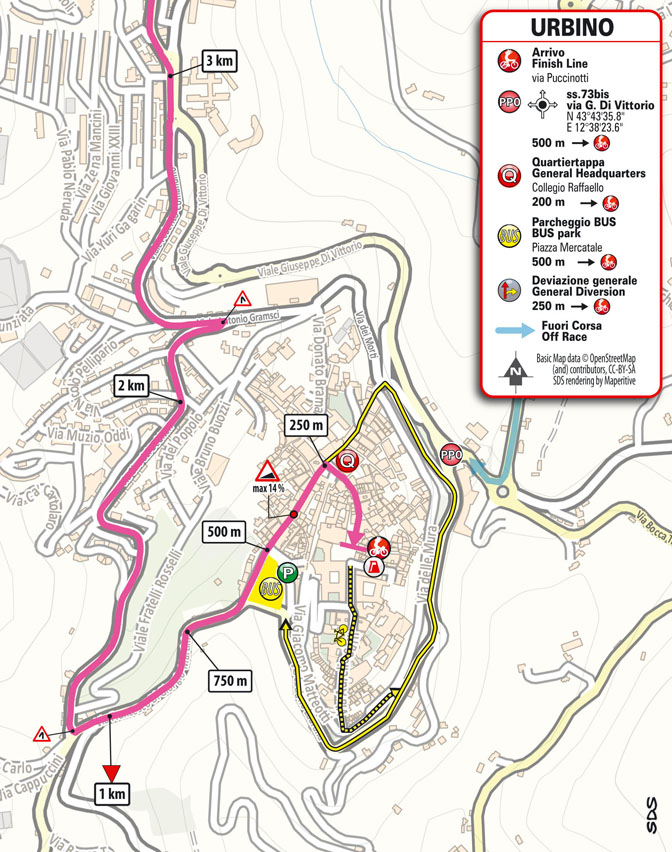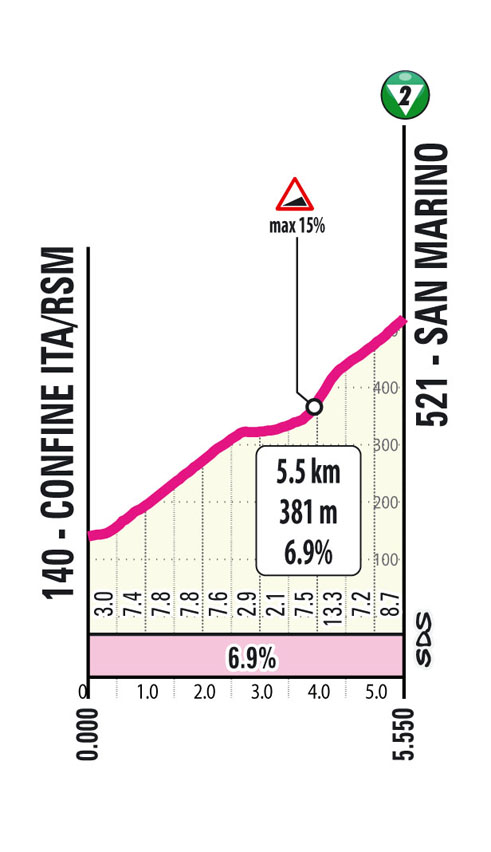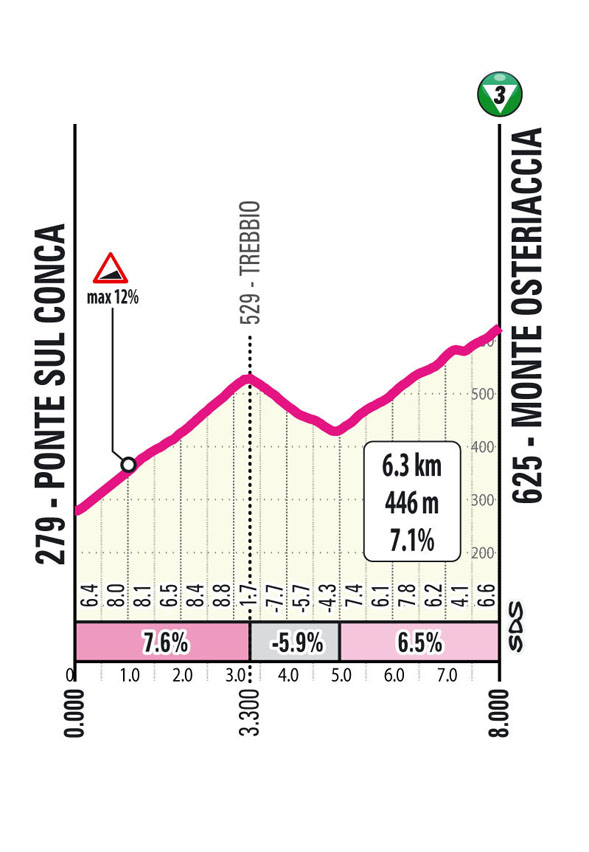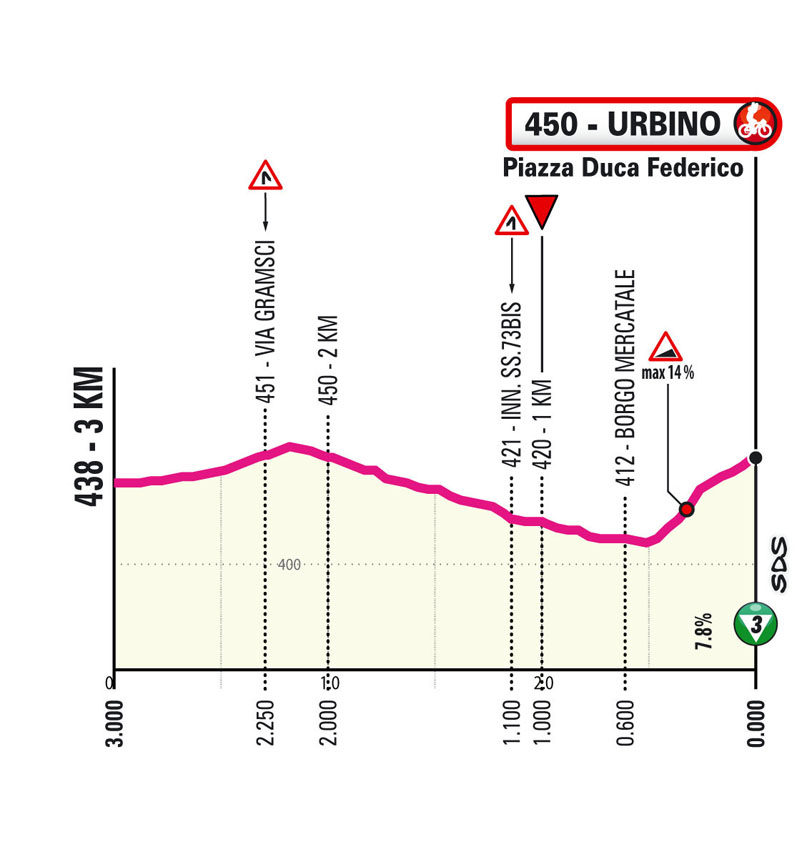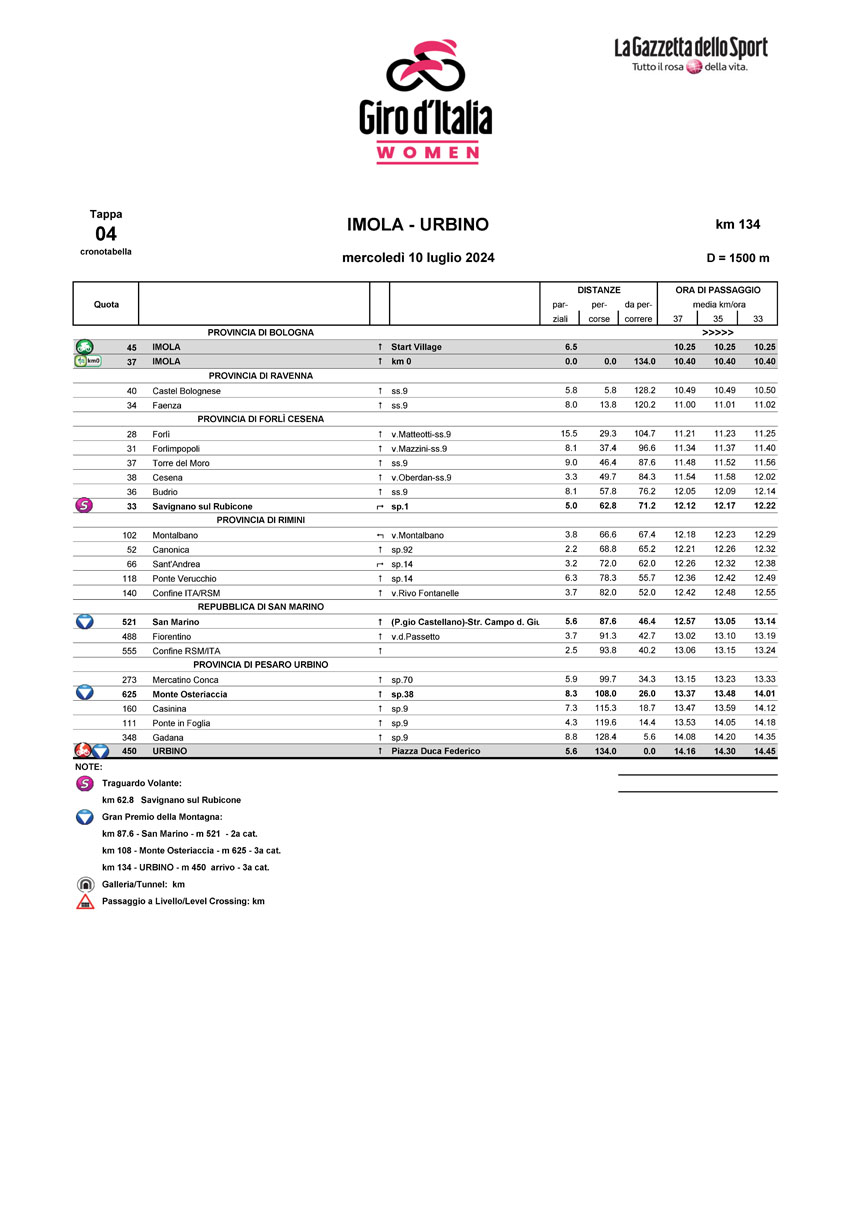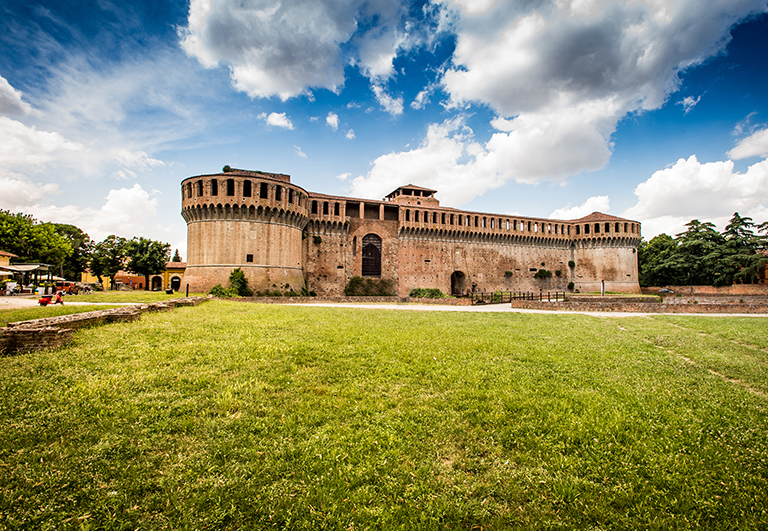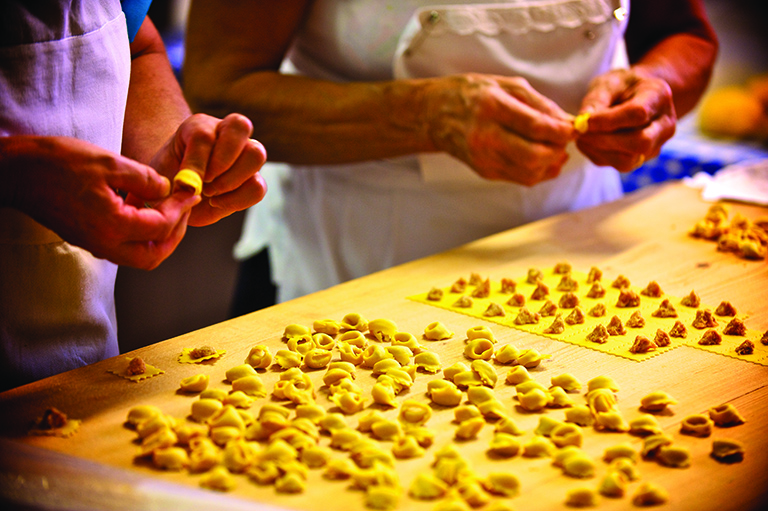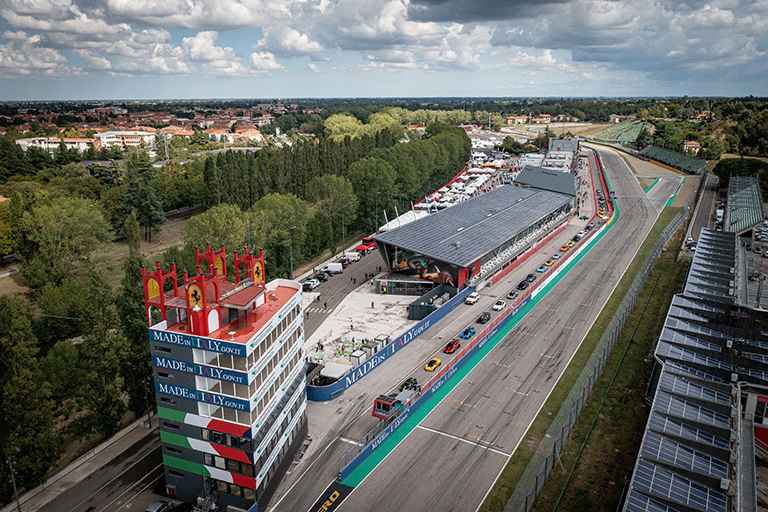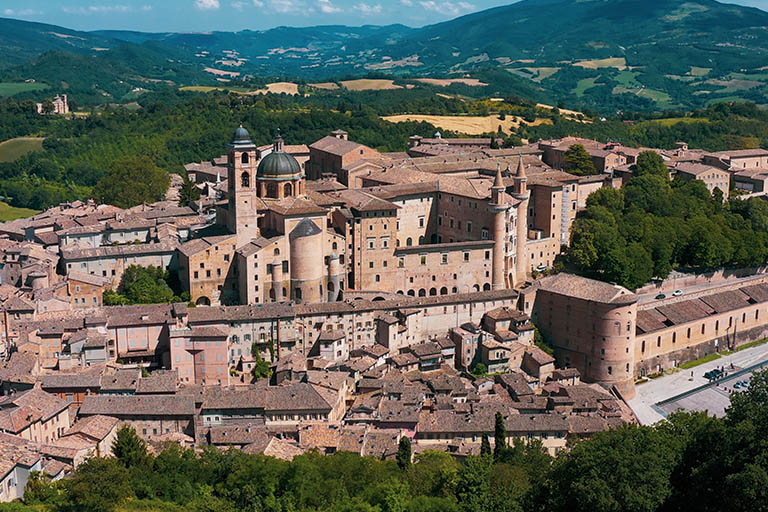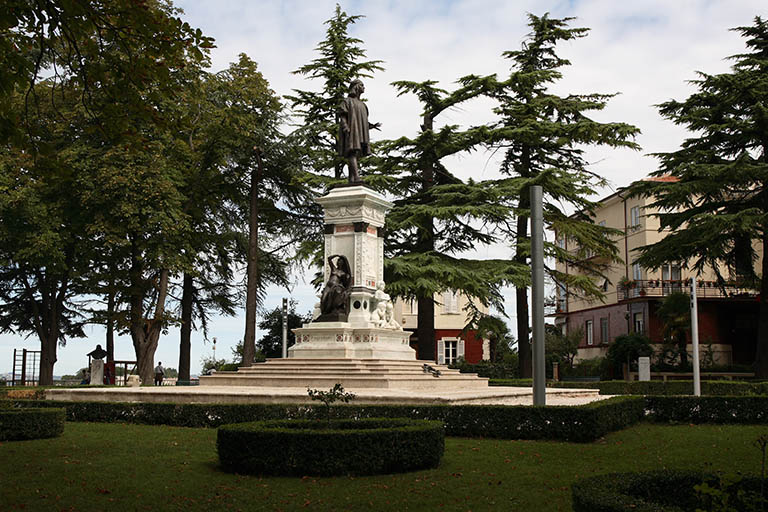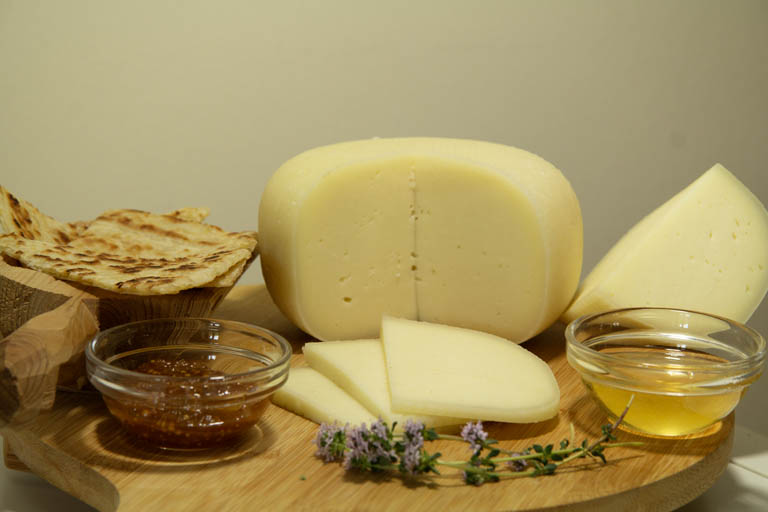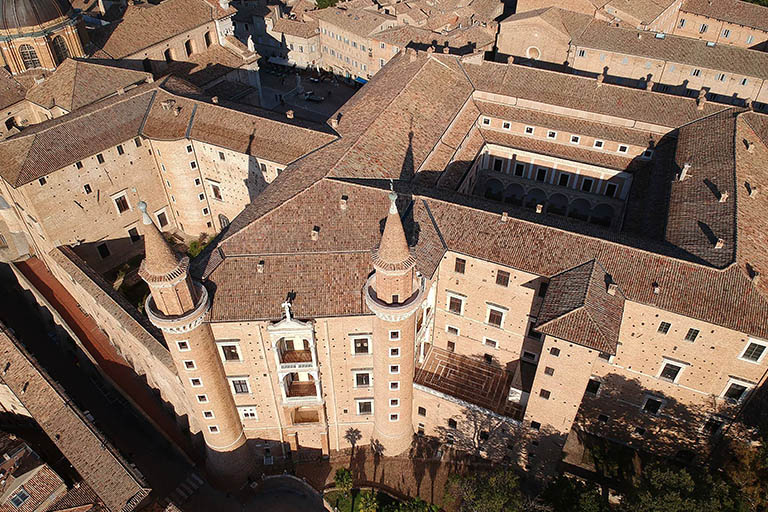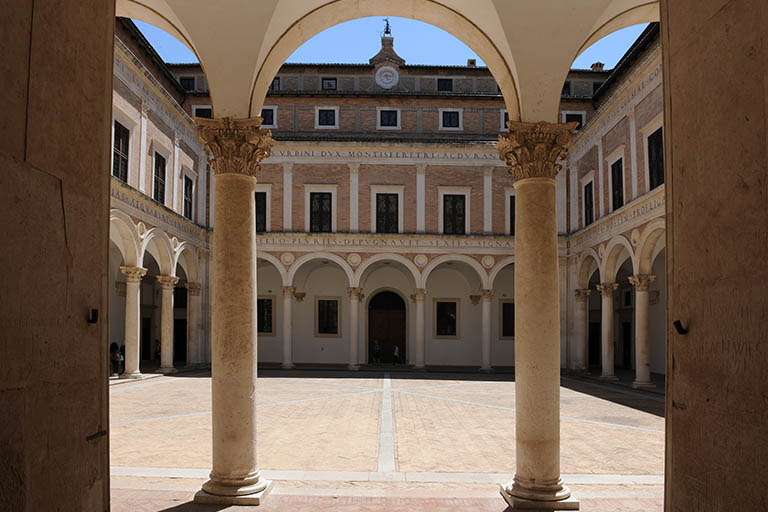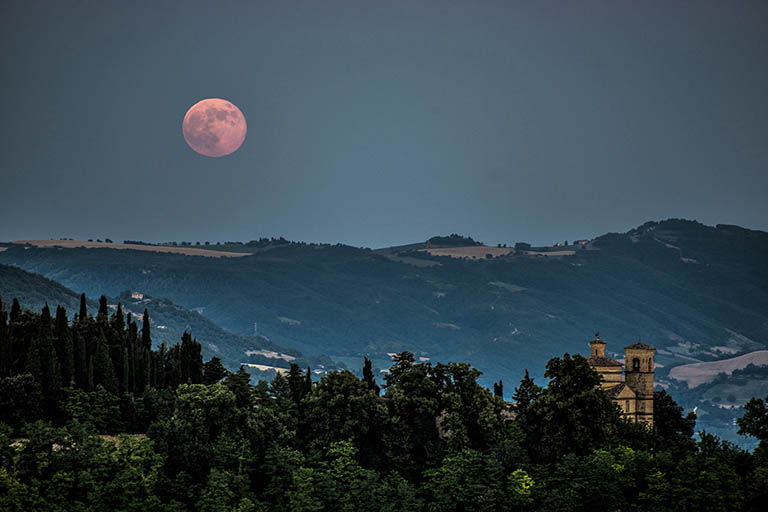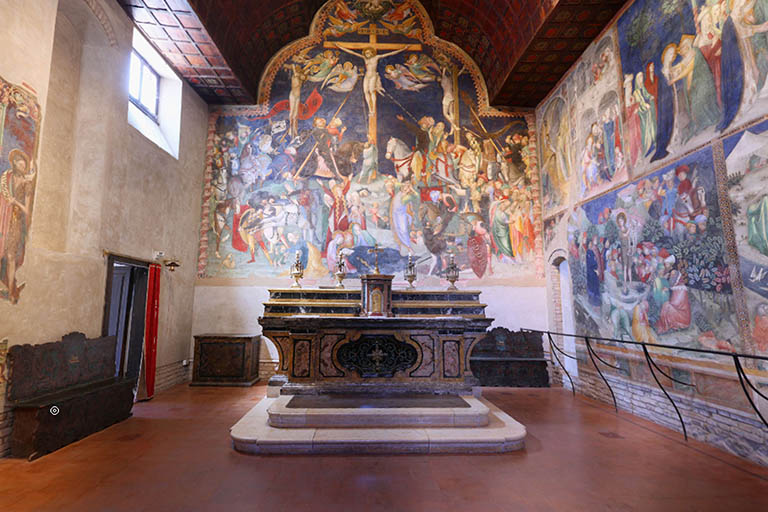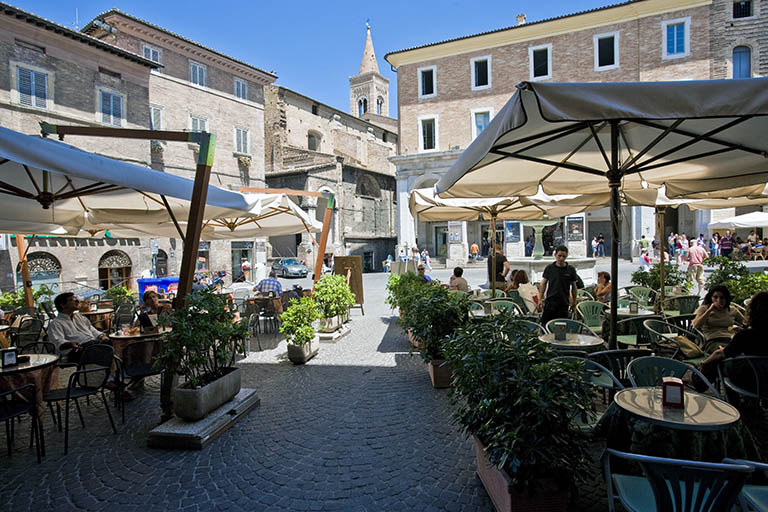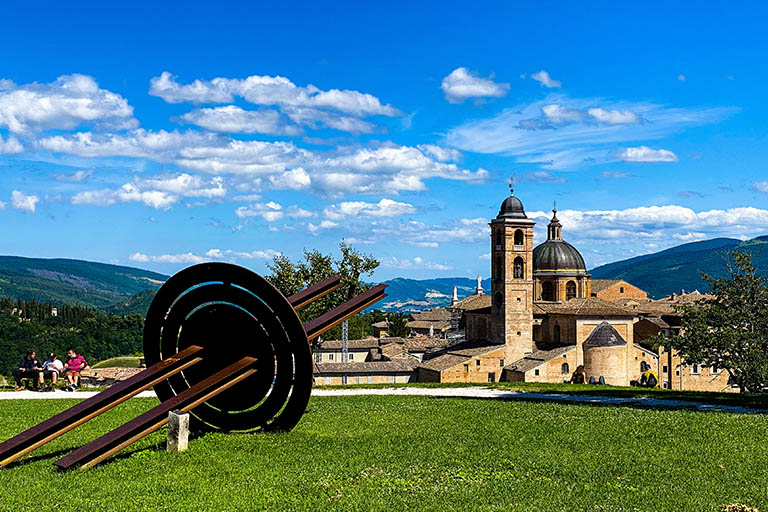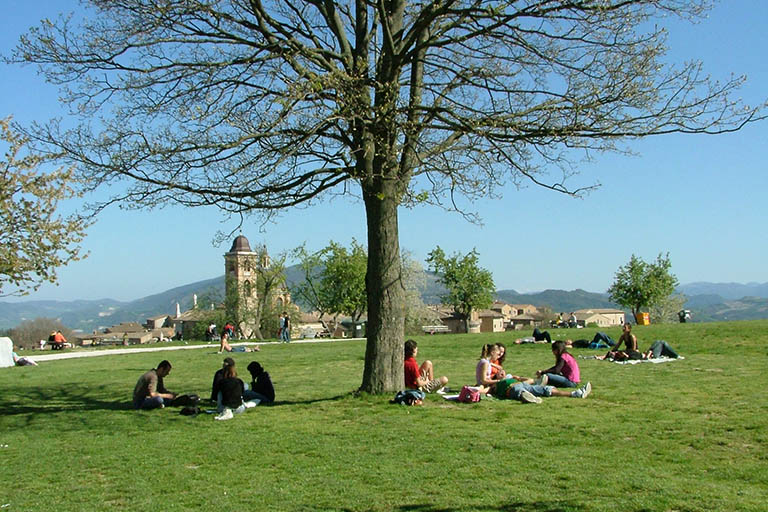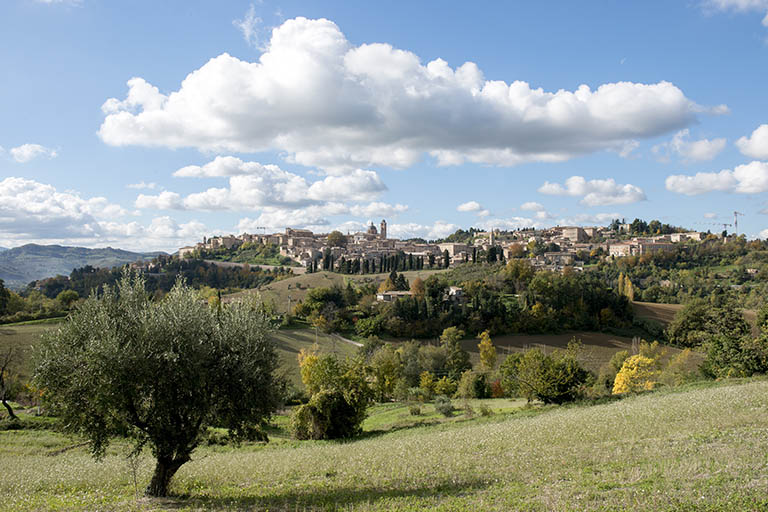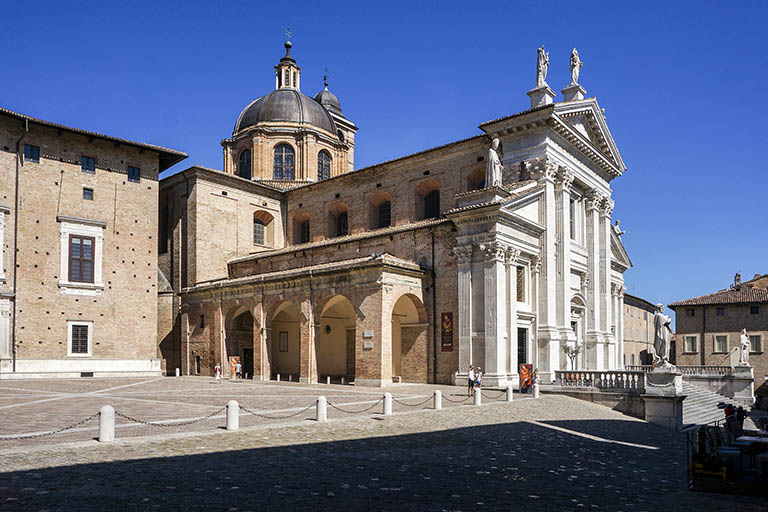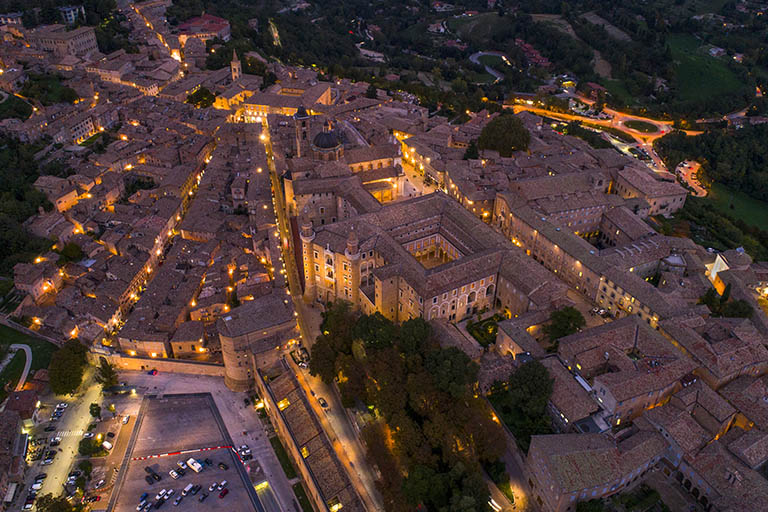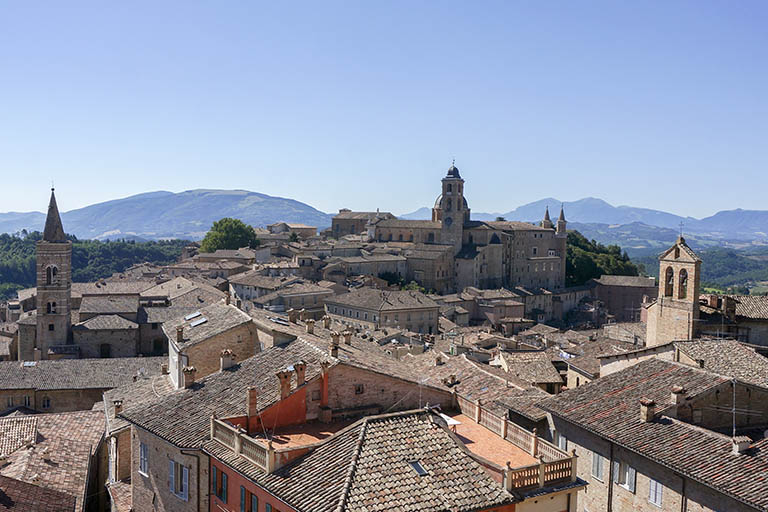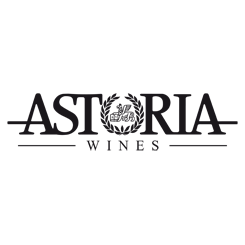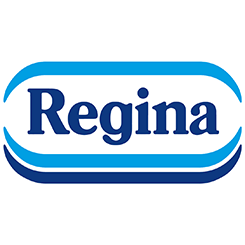profile
map
technical info
Another stage divided into two parts: mostly flat start and very rough finale with another uphill finish. From Imola to Savignano sul Rubicone, the route follows the practically straight and flat Via Emilia, punctuated only by villages and related traffic obstacles. After Savignano, the riders will gradually enter the Romagna Apennines, cross the Republic of San Marino where a cat. 2 KOM is located and then reach Urbino via Mercatino Conca with a few more climbs in addition to the final wall.
Last kilometres
Slight counter slope until the last kilometre, after which the riders will enter a medieval area on porphyry paving with average gradients of 12-14%. The final 100m straight is on cobblestones.
start / finish
climb detail
final kilometres
itinerary timetable
tourist info
Host city:
Imola
Overview
Situated on the banks of the River Santerno, where the Tosco-Romagnolo Apennines meet the Padana Plain, Imola is located in a wonderful position, 30 km from Bologna and only 60 km from the sunny beaches of the Riviera Romagnola. Known all around the world for its racetrack, Imola is the ideal place where you can spend a couple of days enjoying culture, sports and delightful food and wine tours. The elegant mansions and the Rocca Sforzesca are only a few attractions of the historical centre, which can be visited completely on foot. Moreover, the evocative background of the Apennines and the high-level sports facilities make Imola the right place for nature and sports lovers. Imola offers to bicycle lover one of the most developed ciclying paths of Emilia Romagna, covering over 100km, making the two wheels the perfect means of transport to get to know Imola. Imola is also known for its events including races and rock concerts held in the Autodromo, the “Imola in Musica” and the “Baccanale”.
Food & Wine
Remember, Imola is also the gateway to Romagna, which means that any historical-cultural tour simply has to be accompanied by an itinerary for the tastebuds, giving visitors the opportunity to discover the local delights of cappelletti, garganelli, tagliatelle, friggione, piadina, ciambella, ravioli and the excellent Colli d’Imola wines. The Imola area is rich in typical products and traditional recipes, celebrated during festivals. Garganelli, also known as maccheroni al pettine, are one of the staple egg pastas typical of the Imola tradition. Once they were cooked and served in broth, but today they are generally served with various seasonings. Piadina romagnola (“pié” in local dialect) is an unleavened type of bread boasting very ancient origins. It was cooked on “testo”, a stone located on embers which has now been replaced by a regular iron frying pan. Piadina romagnola is the symbol of regional gastronomy and is should be eaten like a sandwich filled with local cold cuts or with soft cheeses such as squacquerone. For over 700 years, the traditional ciambella (a local version of a bundt cake) has also been known as the Brazadela. Usually oval in shape, ciambella has a golden, crunchy outer crust and a fluffy, dry body. Simple, with a slightly rustic flavour, it’s one of those ageless recipes that evokes childhood memories. So good, so genuine: best enjoyed on its own or, as the locals like it, deliciously tociata (dunked) in wine. As for wines, the choice is rich: among the reds, Sangiovese DOC and among the whites, Albana DOCG. The locality is located along the Colli d’Imola Wine and Flavor Trail. For over 30 years, Bacchanal has been held in Imola in November, a festival dedicated entirely to food that involves not only the city but also the surrounding municipalities. The name of the event is clearly a celebration of the god Bacchus, as if to emphasize how the surrounding hills are an ideal territory for the cultivation of vines. Visiting Imola during this event means embarking on a journey into the world of local gastronomy, ranging to ever new and unexpected horizons that place food and wine culture at the center of everything. An ever-changing program full of meetings, exhibitions, shows, tastings, market exhibitions and, of course, thematic menus. The theme chosen for the 2024 edition, scheduled for Oct. 19 to Nov. 10, is “A Thread of Oil,” an expression that refers to multiple aspects of local cuisine and culture. Olive oil in particular (but not only) has accompanied our gastronomic culture for millennia and has maintained, throughout this time, its characteristics and qualities unchanged. Imola’s link with oil has recently been strengthened. In fact, Imola has joined, just in 2024, the National Association of Oil Cities. In closing this brief journey among food and wine excellences, the San Domenico Restaurant in Imola, awarded two Michelin stars, should definitely be mentioned. In business since 1970, the restaurant was born with the idea of showcasing the cuisine of Italy’s noble houses, with great attention to traditional flavors. Today the restaurant is a landmark of international cuisine thanks to the passion and constant research of chef Max Mascia.
Points of Interest
The layout of the city – the ancient colony Forum Cornelii – still recalls the typical pattern of Roman foundations. Embedded in the cobbles – where the via Appia and via Mazzini intersect, almost in the shadow of the municipal clock tower – is a large diamondshaped stone: it marks the exact centre of ancient Roman Imola, the crossroads of the decumanus maximus and cardo maximus. It’s the ideal point from which to begin discovering the town, taking an itinerary that starts beneath the medieval vaulted ceilings of the Palazzo Comunale (Town Hall) and continues beneath the elegant colonnades that flank Piazza Matteotti: colours and materials are those of Romagna tradition, the warm red of terracotta and the delicate yellow of sandstone.
A short distance from the piazza stands one of the most beautiful 18th century buildings in Imola, Palazzo Tozzoni. Donated to the city intact with its furnishings and the family art collection, it is now a splendid civic museum. Visiting the residence-cum-museum of Palazzo Tozzoni is like time travel. It takes visitors directly to bygone centuries, immersing them in the life of an aristocratic family. Continuing along via Garibaldi you come to the Cathedral of San Cassiano, on the right. A little further on comes the town’s symbol, the Rocca Sforzesca, a splendid example of military architecture between the Middle Ages and the Renaissance. Visitors can admire the collections of weapons and ceramics, examine the artillery in the basements, see the dungeons that once held prisoners. The town centre, however, reserves many surprises: at its heart stand the old convent complexes of S. Francesco and S. Domenico, the Museo e Pinacoteca Diocesani e delle Carrozze (Diocesan and Carriage Museum and Art Gallery). The building opposite the Cathedral of San Cassiano once housed the offices and quarters of the high prelates of the town Curia. Even the stable courtyard is a treasure trove, with its lapidarium and a carriage museum displaying the sumptuous coaches of Pope Pius VII, used when he was bishop of Imola. The Hospital Pharmacy, inaugurated in 1794 and largely intact with regards to furnishings and decorations, is a fascinating example of a 18th century pharmacy, enriched by the decorated vaulted ceiling and by 457 antique majolica vases displayed in carved wooden cabinets. The city of Imola is world famous for its circuit, the Autodromo Internazionale Enzo and Dino Ferrari, which has hosted major motorsport events since 1953. Ideal destinations for open air sports and activities are Tozzoni Park, Bosco della Frattona Natural Reserve and the green area of Acque Minerali Park, inside Enzo and Dino Ferrari International Racetrack. For cycling enthusiasts, the Santerno Valley offers scenic vistas of remarkable beauty leading into the territory of the Parco Regionale della Vena del Gesso Romagnola, which has earned recognition as a UNESCO World Heritage Site.
Urbino
Overview
The city of Urbino stands out majestically among the rolling hills of the Marche region. Its Renaissance historic center has been a UNESCO world heritage site since 1998.
Despite having very ancient origins, an important figure was undoubtedly Duke Federico da Montefeltro, who left his mark by building the Palazzo Ducale (now home to the National Gallery of the Marche).Even the famous artist Raphael contributed to the narration of this city since his childhood.In the city of Urbino you can find a perfect and wonderful mix of Art, Taste and Land. Walking through its hidden alleys you will discover the true charm of the city itself, savouring flavors and delicacies at the same time; but not only that, you will also be able to notice the rich particular details that characterize Urbino.The territorial landscape is certainly important and gives a real personality to the city: there are many suggestive places just a few kilometers from Urbino.
Food
- Crescia sfogliata di Urbino: among the typical products of Urbino you can undoubtedly try the famous “Crescia Sfogliata”, that filled with many delicacies, becomes a truly tasty dish. Come and taste it!
- Truffle: it completes every dish by giving the flavor and aroma of typical Marche cuisine.
- Casciotta d’Urbino DOP: it is a typical Renaissance cheese of our territory, which has earned the DOP (protected denomination of origin) mark. Come and taste its sweetness!
Points of Interest
- Palazzo Ducale: Palazzo Ducale is an architectural marvel in Renaissance style. It was commissioned by Duke Federico da Montefeltro and designed by the architect Francesco di Giorgio Martini.Today it hosts the National Gallery of the Marche, where works by Raphael, Titian, Piero della Francesca and Paolo Uccello are exhibited.Furthermore, it is also possible to visit the basement of the Palace and climb up to the top of the Torricini for a 360 degree view of the city and the surrounding area.
- Cattedrale S. Maria Assunta: the majestic Urbino Cathedral is in Neoclassical style. Its facade is adorned with statues symbolizing the Theological Virtues; while inside there are sculptures, liturgical furnishings and works of great importance.
- Oratorio San Giovanni e San Giuseppe: a few steps from Piazza della Repubblica, you can find two jewels: the Oratorio San Giovanni and the Oratorio San Giuseppe. The first is characterized by the cycle of frescoes by the Salimbeni Brothers: they represent the Stories of the life of Saint John the Baptist. The second is famous for its impressive life-size stucco nativity scene created by Federico Brandani.
- Casa Natale di Raffaello: place of birth and educational growth of Raphael, the latter influenced by his father. Inside the house it is possible to observe the furnishings of the rooms where the artist grew up and browse through the paintings by Giovanni Santi and the reproductions of panels by Raphael, the most famous being “The Madonna with Child”.
- Chiesa di San Francesco: it is one of the main places of worship of the Urbinati, considered by them to be the Pantheon of the city, as the most illustrious people of Urbino are buried inside, such as: Federico Barocci, Giovanni Santi and Magia Ciarla (Raphael’s parents).
- Orto Botanico: inside the historic center of Urbino there is a lovely green corner: the Botanical Garden. It is possible to experience a magical atmosphere and discover many species of plants.Today it is a research center of the University of Urbino


